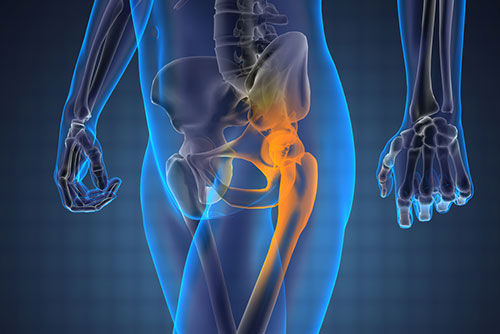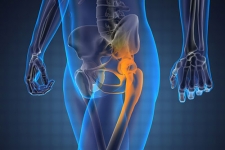
If you’re just starting out on your research journey or have decided upon a total hip replacement, this information will help you understand how the hip works, the most common causes of hip pain, and when hip surgery is recommended. Let’s get started…
How the Hip Works
The hip is the largest joint in the body and is a ball-and-socket joint. The surfaces of the ball and socket are covered with a smooth tissue that cushions the ends of the bones and enables them to move easily. In a healthy hip, the membrane that surrounds the hip makes fluid that lubricates those tissues and eliminates the friction when the hip moves.
What Causes Hip Pain
Arthritis is the most common cause of hip pain and disability. The different types of arthritis that commonly impact the hips are osteoarthritis, rheumatoid arthritis, and traumatic arthritis.
Osteoarthritis
Osteoarthritis forms when the cartilage that cushions the ends of the bones wears down over time. When the cartilage deteriorates, the bones will rub together, which causes pain and stiffness. This disease comes along with the “wear and tear” of aging. It’s most prominent in individuals over the age of 50 and who have a family history of arthritis.
Rheumatoid Arthritis
Rheumatoid arthritis is when the membrane that helps the joints move smoothly becomes inflamed and thickened. As it becomes more inflamed, the more painful, tender, and swollen the joints become. It may be difficult to move the joints as well. Researchers have yet to find the cause of RA, but they believe individuals may have certain genes that are triggered by external factors like the environment or stress.
Post-Traumatic Arthritis
Post-Traumatic Arthritis develops after a physical injury, like a hip fracture. Injuries frequently cause damage to the cartilage or bone, which then changes the mechanics of the joint structure and makes it wear out more quickly. As it wears out, the hip develops pain and stiffness.
Osteonecrosis
As a result of an injury to the hip, the blood supply to the femur may be disrupted. If the bone doesn’t get the proper amount of blood to stay healthy, it can lead to the surface of the bone collapsing and developing arthritis.
Childhood Hip Disease
Some infants and children develop a rare hip disease that causes pain, irritation, and stiffness. Yet again, this condition commonly forms when the femur’s blood supply is cut off and begins to destruct the joint structure. This disease is successfully treated during childhood, but they may still develop arthritis later on in life.
When Is Surgery Recommended
When a hip has been significantly damaged by arthritis, a fracture, or other conditions, a total hip replacement may be considered. In a total hip replacement, the damaged bone and cartilage are removed and then replaced with prosthetic components.
As stated by OrthoInfo, a total hip replacement surgery may be recommended to you because of the following:
- Hip pain limits everyday activities, like walking and bending
- Hip pain continues while resting
- Stiffness that limits the ability to move or lift the leg
- Inadequate pain relief from anti-inflammatory drugs, physical therapy, or walking supports
A hip replacement will not completely replace your hip. Like every joint, even a hip replacement can wear down. High-impact activities and being overweight will cause a hip replacement to wear down faster than usual.
Recipients of hip replacements can still remain active through low-impact activities such as golfing, walking, swimming, or hiking. It’s recommended to stay active and maintain a healthy lifestyle to increase the longevity of the hip replacement.
Closing Thoughts
If you’d like to learn more about total hip replacement and see if it’s right for you, please contact us at Prairie Orthopaedic & Plastic Surgery. Our experienced providers and team are committed to giving you the best care and treatment for your specific condition. Give us a call at to schedule a consultation.
Resources: Total Hip Replacement, OrthoInfo

